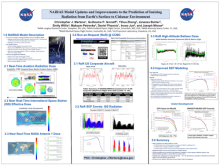NAIRAS Model Updates and Improvements to the Prediction of Ionizing Radiation from Earth’s Surface to Cislunar Environment
Christopher
Mertens
NASA Langley Research Center
Poster
The Nowcast of Aerospace Ionizing RAdiation System (NAIRAS) predicts dosimetric quantities for assessing human radiation exposure and differential and integral flux quantities for assessing single event effects from galactic cosmic rays, trapped inner belt protons, and solar energetic particles (SEP) from the Earth’s surface to the space environment. NAIRAS is composed of coupled physics-based models that transport ionizing radiation through the heliosphere, Earth’s magnetosphere, the neutral atmosphere, and aircraft or spacecraft shielding. Recent updates to NAIRAS include the transition to prototype operations at the Community Coordinated Modeling Center (CCMC) where the model now operates in two modes: (1) real-time global predictions of the atmospheric radiation environment (0-90 km) and (2) a run-on-request (RoR) service allowing the user to select a specific time period for the global dosimetric calculations, or to upload an aircraft, balloon, or spaceflight trajectory file to provide predictions of the dosimetric and flux quantities along the flight path. The trapped proton model and the differential and integral flux quantities are also recent updates to NAIRAS. The NAIRAS model improvements include a more accurate atmospheric ionizing radiation transport method and more robust and reliable SEP predictions. The NAIRAS model updates and improvements are described, and results are shown for aircraft, high-altitude balloon, low-Earth and medium-Earth orbits, and the NASA Artemis 1 cislunar flight. The range of flights examined occurred during both quiescent and solar-geomagnetic disturbed conditions. Model comparisons with measurement data are also shown.

Poster PDF
Poster category
Aviation Radiation Research and Applications
Meeting homepage